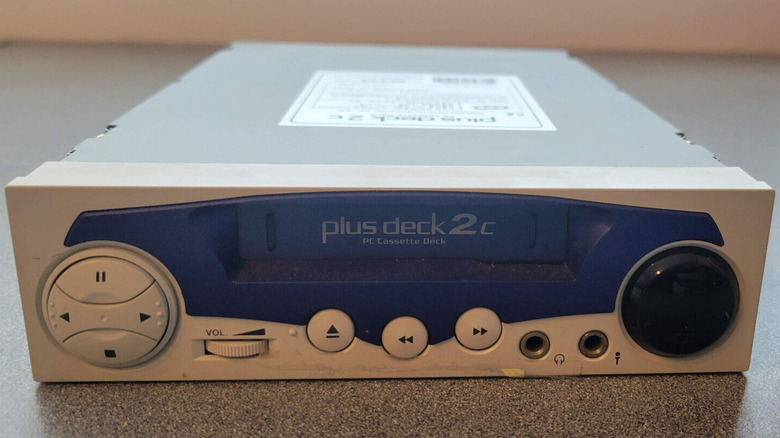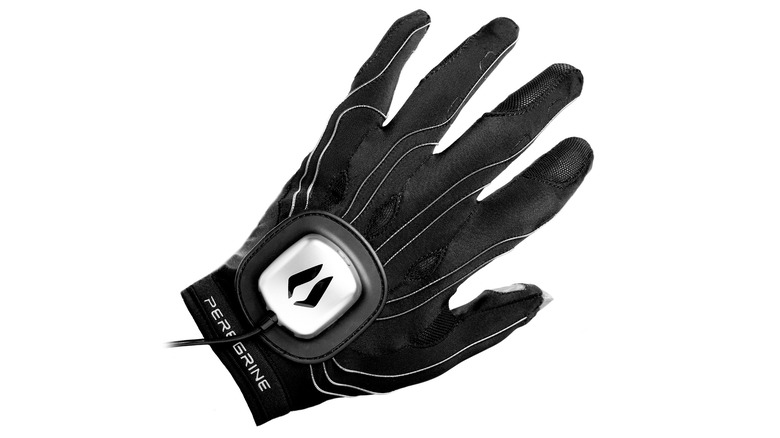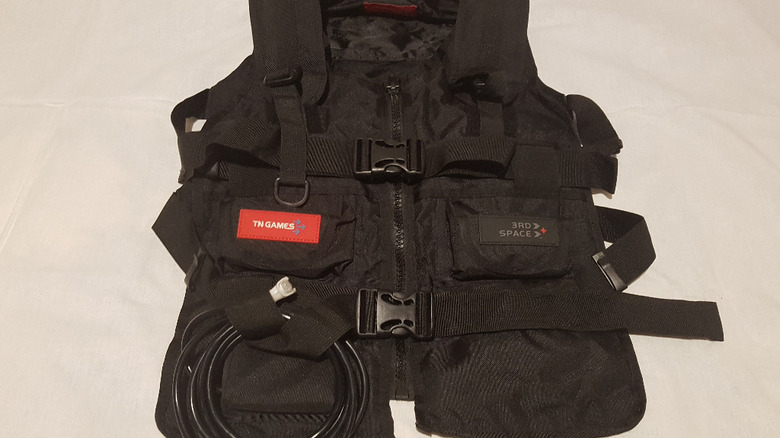5 Of The Weirdest PC Accessories We Can't Believe Actually Exist
In the decades since the modern era of personal computers began, the PC accessory market has kicked out tens of thousands of different gadgets, gimmicks, and gizmos to use. According to Straights Research, the global accessories market was valued at $8.65 billion in 2021, and anticipates reaching $24.38 billion by 2030 — with a compound annual growth rate of 12.2% (from 2022-2030). Business Wire pegged growth in the market between 2020-2024 at $2.86 billion.
Most of those gadgets have been aimed at one particular market segment because, if we're being honest, gamers love their toys. The more immersive, the better. We will give it a whirl if an accessory can provide gamers with even the slightest edge, and companies know this.
With that, this list doesn't contain keyboards (like the torturous SafeType), or the endless array of weird mice or gamepads (i.e., the AlphaGrip AG-5), because those are easy fodder. The peripheral market is filled to excess with alternatives for each of those and, on their own, probably constitutes a majority of the accessory market.
We dove deep for items and stumbled onto some truly bizarre paraphernalia that had even some of our more seasoned PC enthusiasts scratching their heads.
PlusDeck PC Cassette Deck
This doodad is precisely what you think it is — an audio cassette player that fits into an empty 5.25" drive bay in your desktop computer. BTO (which stands for "Beyond the Ordinary") Company Limited was founded in Seoul, Korea, in 2000. The first version of its PlusDeck was released in December 2001 for $150.
It could record MP3s and online audio to cassette tape using a PC, despite a handful of higher-tech options available to the masses at the time, including CD-ROMS, which had been widely available in the United States since 1983. Not only that, but CD-Recordable (CD-R) drives had been out for nearly a decade (since 1991), and CD-ReWritable (CD-RW) drives came on to the market in 1997. Oh, and USB had been popular since 1998.
This didn't stop BTO from releasing an updated PlusDeck 2 in late 2003 (at the same price), with the third and final version — the PlusDeck 2c — dropping in 2006 at $130. The price decrease most likely had to do with the fact that this new version could no longer record from any source — eliminating any potential usefulness this module had.
One has to wonder if the successful copyright infringement lawsuits against Napster in 2001 had something to do with eliminating the record feature. Still, why BTO thought there were enough people still using cassettes and making mix tapes in the early 2000s to warrant this product is perplexing.
DigiScents iSmell
Technically, this odiferous doohickey wasn't released, but once we got a whiff (pun intended) of the "iSmell" from DigiScent, we had to include it. DigiScent launched in February 1999 and quickly raised $20 million through Asian investors to get iSmell off the ground, just a few months after the first iMac went on sale.
DigiScents wanted to revolutionize the entertainment industry. Web surfers would be able to sample scents of the perfume's on Chanel's website, while gamers would be able to waft the acrid smell of gunpowder in first-person shooters, and movie goers could actually experience what napalm smelled like (if they wanted).
They hired a sensory psychologist who came up with 100-200 primary scents that could be combined to create the aroma of nearly "anything in the natural world." The prototype looked like a shark's fin with tiny holes, and was hooked to a PC via a serial cable or USB plug. Sitting inside the fin were numerous vials of the primary scents, which would then be combined and dispersed via fans inside the housing.
In a Wired Magazine interview/presentation in November '99, the iSmell appeared to really impress. Sadly, it was only a great idea in theory — not so much in practice. Two years after the prototype was built, the company ran out of money and closed without selling a single unit.
Peregrine Gaming Glove
Anyone who was a gamer in the early '90s knew about Nintendo's Power Glove. It was the single coolest-looking peripheral that had ever come out — all that potential, all that power ... all that failure. You would think other companies would have learned from this. They did not.
Where the Power Glove basically took a Nintendo controller and slapped it on a glove, Iron Will Innovations and Y Studios used actual sensors embedded in its glove to read and understand hand movements. When the Peregrine Gaming Glove was announced at E3 2009, people were intrigued. Preorders started a month after E3 in July for $99, and the glove sold at a $129 MSRP when it shipped that fall.
According to Y Studios, the Peregrine is a "wearable interface" best used for Real-Time Strategy (RTS) or Massively Multiplayer Online (MMO) games that could be used in conjunction with a keyboard, or replace it entirely. The glove was made of breathable fabric with a magnetic break-away connector, and could perform over 30 actions with your fingertips — and therein lies the problem.
The Peregrine wasn't actually reading hand gestures because you had to interact with different TouchPoints (18 of them, to be exact) located on your fingers and palm. It was more or less like putting 18 buttons on a mouse.
Over the years, they've been developing a VR version of the glove, currently offered at a pre-release cost of $2,000. Iron will, indeed.
3rd Space Gaming Vest
Developed by TN Games back in 2007, the 3rd Space Gaming Vest (aka, the ForceWear Vest) evolved from recycled medical equipment designed by Dr. Mark Ombrellaro.
The force feedback contraption used a compression system that pumped air into the vest through tubing connected to an external compressor (with a separate power source). Inside the vest are eight pneumatic cells — four in the front and four in the back — that would inflate to approximate the feeling of getting shot. Each contact point could generate up to 10 pounds of force, so it was not insignificant. Ombrellaror claimed the vest could simulate single and multiple gunshot wounds from various guns, missile strikes, explosions and melee attacks like kicks and punches.
There were plans to create a whole line of products with various designs and additional contact points for the arms, legs, and head, giving the wearer a fully immersive experience. The vest was released in November 2007, and retailed for $189.99. By Christmas of 2008, the vest had the backing of over two dozen high-profile FPS games including, "Bioshock," "Call of Duty 4," "Mass Effect," and even two MMORPGs in "Fable" and "World of Warcraft."
Despite making it onto at least one well-regarded Holiday Buyer Guide and garnering decent reviews, the vest never caught fire with the gaming community.
Plawa KeyStik
We're putting the KeyStick on the list due to the sheer audacity (or brilliance, depending on your perspective) of the company calling this an accessory and charging money for it. German company Plawa wasn't the only company to come up with some cheap little plastic gizmo that clipped onto a standard mechanical keyboard to provide a faux joystick, but it might have been the most thoroughly designed — though that's not saying much.
KeyStick touted that it didn't need batteries, an extra game port, or even additional software installed for it to function correctly. Seriously? And if you're getting charged $12.95 for a thing, you want that thing to work. When you moved the joystick, a mechanism pushed down one of four individual plungers that would, in turn, depress a respective key on the board. Rather squeakily, we might add, but it worked.
Apparently, it was pretty popular in Portugal and mainly used for playing soccer and fighting games. Even though all it did was push down on the existing arrow keys on your keyboard. All these accessories prove that the buyer really needs to be aware of what they're buying, all the time, through every decade.



